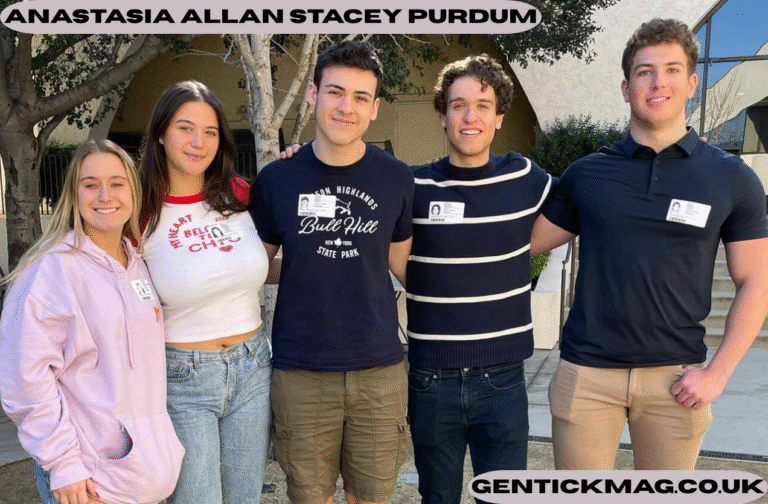Anastasia Allan Stacey Purdum, ?? – A Deep Dive into the Names and Their Significance
In today’s increasingly interconnected digital landscape, names often serve as windows into identities, family heritage, or even mystery. Among those that have generated curiosity is the phrase “anastasia allan stacey purdum, ??” – a combination of names that appears to bring together multiple personas, potentially referring to individuals, familial ties, or internet discourse. This article will delve into the intricacies of these names, analyze their possible significance, and explore the broader context in which they may exist.
Understanding the Name: Anastasia Allan Stacey Purdum, ??

The combination “anastasia allan stacey purdum, ??” stands out not only due to its complexity but also because of the suggestion of ambiguity implied by the double question marks. Breaking the name down into its constituent parts—Anastasia, Allan, Stacey, and Purdum—raises questions: Are these names of separate individuals? Do they form part of a lineage? Or do they represent online identifiers? The use of “??” hints at mystery or unresolved identity, inviting speculation.
Anastasia: A Name of Legacy and Cultural Weight

The name Anastasia carries with it a historical and cultural resonance, famously tied to Russian royalty—Anastasia Romanov, the daughter of Tsar Nicholas II. The name is often associated with elegance, strength, and tragedy. In contemporary use, Anastasia is often chosen for its beauty and uniqueness, suggesting someone with strong presence and individuality. If referring to a real person in the phrase, the individual named Anastasia may carry a sense of distinction or be part of a narrative that stands apart.
Allan: Masculine Given Name or Family Surname?
Allan typically functions either as a masculine first name or a surname of Scottish origin. It signifies “handsome” or “cheerful” and has long been associated with literature and nobility. In the context of “anastasia allan stacey purdum,” Allan could be interpreted in several ways:
- As a middle name for someone named Anastasia Allan.
- As a surname connecting two people: Anastasia (first name) and Allan (last name).
- Or, part of a composite name chain.
Regardless, its placement between Anastasia and Stacey suggests an intentional sequencing.
Stacey: Unisex Name with Feminine Leanings
Stacey is widely recognized as a gender-neutral name, though predominantly used for females. Originating from the medieval name Eustace, meaning “fruitful” or “productive,” Stacey brings a more contemporary Western flavor to the name combination. In cultural references, Stacey can signify both creativity and a grounded personality. Its presence in this sequence again raises questions: Is Stacey an individual separate from Anastasia, or is the phrase forming a full name like “Anastasia Allan-Stacey Purdum”?
Purdum: An Uncommon Surname with Genealogical Roots
The surname Purdum is far less common, which often suggests a more traceable lineage or smaller genealogical tree. It can be found in North America, possibly linked to families that migrated from England or Ireland. The rarity of this surname adds a level of uniqueness to the phrase “anastasia allan stacey purdum.” It could be the surname anchoring the previous names, indicating that all the preceding ones are middle or first names in full.
Who Could Anastasia Allan Stacey Purdum Be?
Taking all the parts together—Anastasia Allan Stacey Purdum—the question arises: is this a single person’s full name or a compilation of individuals linked by family, history, or context?
Some plausible interpretations include:
- A single individual with an extended legal or chosen name.
- A hybrid of family members’ names to represent a lineage or collective tribute.
- An online identifier or persona combining various names to reflect multiple influences.
- A symbolic or fictional name constructed for artistic or investigative purposes.
The “??” at the end adds a layer of uncertainty or intrigue, perhaps reflecting ongoing investigation or public curiosity.
The Digital Dimension: Names as Search Terms and Identities
In the digital age, the combination “anastasia allan stacey purdum” may be more than just a name. It could be a search phrase, the result of a merged database entry, or even a mysterious keyword from online forums, genealogy websites, or archives. Many individuals researching ancestry or public records often encounter long strings of names that seem connected but aren’t immediately explainable.
The double question marks might indicate a record that’s incomplete or a reference still being explored. This is common in genealogy, criminal justice databases, or even obituaries, where names can get grouped before all facts are confirmed.
Gender and Identity Implications
Another layer to consider is gender identity and representation. The names in question span traditional gender lines—Anastasia (female), Allan (male), and Stacey (unisex). When combined, they may represent a nonbinary or fluid identity, or perhaps someone with evolving gender roles or cultural heritage.
Names today are increasingly being used to reflect personal journeys—spiritual, emotional, or even political. Therefore, “anastasia allan stacey purdum” could be a constructed identity reflecting that movement.
The Role of Family and Ancestry
There’s also a strong possibility that this combination of names points to a family story—perhaps parents and children, siblings, or ancestral names joined together. This is common in obituaries, memorials, or family tree research, where names appear in sequences to reflect relations.
Imagine a scenario where Anastasia Allan is a mother, Stacey Purdum a daughter, or vice versa. The conjoining could represent love, remembrance, or simply documentation. The mystery indicated by “??” could mean that the full connection is not yet uncovered or that a narrative still needs to be told.
Fictional or Symbolic Construction?
It is also possible that the name “anastasia allan stacey purdum” has been constructed for symbolic or fictional use. Authors and screenwriters often blend names to create characters that feel real or that symbolically represent larger ideas.
In such a scenario:
- Anastasia could symbolize royalty or elegance.
- Allan could stand for masculinity or tradition.
- Stacey for modernity or gender neutrality.
- Purdum as an anchor to family or origin.
The name, in total, might appear in a novel, screenplay, or artistic work that hasn’t reached widespread publication yet but exists in public search databases.
Frequently Asked Questions (FAQs)
Q: Is “anastasia allan stacey purdum” a real person?
A: It’s unclear. The name could refer to a real individual, a combination of multiple people, or even a fictional creation. The ambiguity makes it difficult to confirm without further context.
Q: What does the “??” mean after the name?
A: It likely indicates mystery, uncertainty, or ongoing investigation. In databases and forums, “??” is often used when information is incomplete or speculative.
Q: Could this be a genealogy or obituary listing?
A: Possibly. The structure and combination of names fit the pattern of familial or memorial references where several individuals are listed together.
Q: Why are people searching for “anastasia allan stacey purdum” online?
A: Curiosity, research, or reference from another document or forum might have prompted public interest. The name combination stands out, triggering further searches.
Q: Is there any known connection between the names?
A: Not directly confirmed, but they may represent family relations, a full legal name, or a constructed narrative.
Conclusion: The Enduring Curiosity Around Anastasia Allan Stacey Purdum, ??
The phrase “anastasia allan stacey purdum, ??” lingers in the digital consciousness as a blend of personal identity, mystery, and potential narrative. Whether it refers to a singular person, a web of familial ties, or a symbolic creation, it draws attention due to its layered structure and the presence of unanswered questions.
